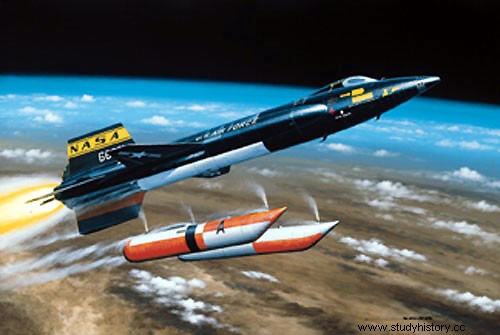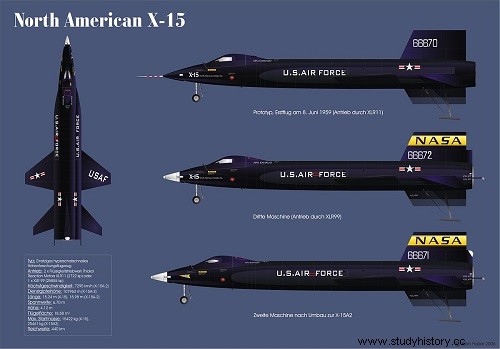
The North American X-15 is an American experimental rocket plane, built as part of a research program on very high speed and very high altitude flight. From 1960 to 1968, the 3 examples built performed approximately 200 test flights on behalf of NASA, smashing all speed and altitude records held by a fixed-wing manned aircraft.
The X-15 set definitive records of 7,272.68 km/h for speed (October 3, 1967) and 107,960 meters for altitude (August 23, 1963). It enabled the Americans to collect a great deal of data on the behavior of air flows, aerodynamic friction, the control and stability of an aircraft at high speed and out of the atmosphere, as well as re-entry techniques. the atmosphere.
The X-15
In February 1954, the National Advisory Committee for Aeronautics (ancestor of NASA) established the need for a new experimental aircraft to explore very high speed and very high altitude flights. A team of researchers was tasked with finding solutions to the many problems posed (kinetic heating, control of the aircraft in a rarefied atmosphere, optimal aerodynamic configuration, etc.) and submitted a report in April 1954, indicating that it there is no major obstacle given the techniques of the time.
The launch of the project was validated in October 1954, with 95% funding by the US Air Force and 5% by the US Navy, and a call for tenders was launched immediately after. North American's proposal was accepted and an order for the construction of 3 copies was signed in December 1955. In February 1956, the development of the rocket engine was entrusted to Reaction Motors, which offered a propellant derived from that of the Viking rockets.
A model was presented by North American in December 1956. Aircraft construction began in mid-1957 and the first X-15 left the factory on October 15, 1958. The XLR99 engine was, however, very late, since the first was not delivered. only in April 1959 and that it is still necessary to wait almost one more year so that it is finally qualified. During this time, two Boeing B-52 Stratofortress are modified to be able to carry the X-15 at altitude. Future pilots are selected and a simulator built to train them.
The first test flights took place as follows:
March 10, 1959, first "tethered" flight of X-15 number 1, which remained attached under the wing of the B-52 carrier
June 8, 1959, first flight without using the engines of the X-15 number 1
September 17, 1959, first flight of X-15 number 2 powered by two provisional XLR 11 engines
November 15, 1960, first flight of X -15 number 2 powered by the definitive XLR99 engine
These first tests were strewn with numerous technical problems leading either to the postponement of the planned flights, or the interruption of a flight in progress. The tests continued despite everything and, by the end of 1960, the X-15 had exceeded Mach 3 and 30,000 m in altitude. The plane was then transferred to NASA for research flights.
The X-15A-2
After the accident of November 1962 (see below), it was decided to rebuild the X-15 number 2 by modifying it on the one hand to make it capable of reaching a speed of Mach 8 and, on the other hand , so that it could serve as a flying test bed for a ramjet. The plane then receives the designation of X-15A-2.
The higher speed must be obtained by increasing the operating time of the rocket engine, which a priori simply requires increasing the fuel/oxidizer capacity. To do this, the fuselage was lengthened and two additional external tanks installed (one on each side of the fuselage):these tanks were emptied first, then dropped in flight and recovered.
In order for the X-15 to withstand higher temperatures than expected, it was decided to cover it with an additional layer of insulation which gradually disintegrates in flight. For its part, the ventral fin is modified to be able to install a ramjet 91 cm in diameter. As there is no longer any question of ejecting the lower part in flight, the ground clearance must be increased.
Finally, new compartments are installed to carry measuring equipment. The X-15A-2 finally weighs 10 tons more than the X-15, which also requires seriously reinforcing the landing gear.
The X-15A-2 with its layer of insulation and its external tanks, under the wing of the B-52 carrier.
The new aircraft then undergoes a test cycle:
June 15, 1964, first "tethered" flight while hanging under the wing of the B-52 payload
June 25, 1964, first real flight without the tanks or the ramjet
February 17, 1965, first flight with the new measuring equipment
November 3, 1965, first flight with empty external tanks
July 1, 1966, first flight with the external tanks filled
August 21, 1967, first flight with the additional insulation layer
The first flights were marked by several incidents due to the landing gear, which tended to deploy in mid-flight.
It was the X-15A-2 that set the speed record by reaching 7,272.68 km/h (October 3, 1967). However, during this flight, the surface temperature exceeded the expected 1,300°C and caused significant damage to part of the airframe. Although North American restored the aircraft, it ultimately never flew again.
Research Flights
The research flights conducted by NASA initially consisted of gradually increasing speed and altitude:
First flight above Mach 4 on March 7, 1961
First flight above Mach 5 on June 23, 1961
First flight above 200,000 feet ( 60,960 meters) on October 11, 1961
First flight above Mach 6 on November 9, 1961
First flight above 300,000 feet (91,440 meters ) July 17, 1962
In April 1962, NASA engaged the X-15 in a research program that included a number of scientific experiments, in addition to experiments and measurements carried out on the aircraft itself. In 1963/1964, the X-15 also participated in the development of reconnaissance systems for the Lockheed A-12 Oxcart. Depending on the needs, various additional sensors are added to obtain the desired measurements:spectrum of sunlight, ultraviolet radiation, density of micro-meteorites, etc. From February 1965, the new measuring equipment of the X-15A-2 was used for the various scientific experiments planned.
The program was stopped in 1968, mainly following the loss of X-15 number 3 and a reorientation of NASA budgets. The last flight of an X-15 took place on October 24, 1968.
Crashes
On November 5, 1959, the X-15 number 2 suddenly doubled over during landing, following a somewhat brutal touchdown due to a greater mass than expected. The pilot escaped safe and sound. The flight had been interrupted due to a fire on one of the two XLR11 engines.
On June 8, 1960, a ground test of the definitive XLR99 engine ended with the destruction of the entire rear of X-15 number 3 due to an explosion. The pilot escapes unscathed.
On November 9, 1962, the X-15 number 2 was very seriously damaged and its pilot John B. McKay seriously injured during a landing:following a failure of the control surfaces, the plane touched the ground much too quickly (at 480 km/h) and the left pad bends under the impact. The X-15 then rolls over before falling on its back.
On November 15, 1967, the X-15 number 3, which had become uncontrollable, was subjected to too high load factors during the descent and disintegrated in flight. The pilot, Michael J. Adams, is killed.
Drivers
X-15 pilots receive numerous medals and honors for their work and the results achieved. Eight of them exceed the altitude of 50 miles (80 km) and thus earn the title of astronaut according to USAF criteria:
The official international limit of space being fixed at an altitude of 100 km, this title of astronaut is in fact recognized only by the US Air Force, except for Joseph Albert Walker, who exceeded it at two occasions.
Other features
Unable to take off under its own power, the X-15 is hung under the wing of a Boeing B-52 Stratofortress and then dropped at an altitude of more than 15,000 meters (45,000 feet). The rocket engine is then ignited to propel the plane into the upper atmosphere, then the X-15 follows a ballistic trajectory before descending in free flight like a glider.
The plane lands on two retractable skids at the rear and a roller at the front. Beforehand, the lower part of the ventral fin must be ejected because it is too large compared to the ground clearance of the X-15.
The X-15 is constructed with various special alloys, including Inconel capable of withstanding temperatures of 800°C.
Most of the fuselage contains a tank for 3,914 liters of liquid oxygen (oxidant) and another for 5,470 liters of ethanol or ammonia (fuel).
At very high altitude, directional control is no longer provided by conventional control surfaces, but by 12 small hydrogen peroxide rockets placed in the nose and at the wingtips.
The X-15 is full of measuring instruments intended to collect data during flights:temperature, pressure, load factors, flight parameters, physiological parameters of the pilot, etc.
The ejection seat can be used up to the speed of Mach 4 and the altitude of 36,600 meters.
Popular culture
After witnessing a Neil Armstrong flight aboard the X-15, Jean-Michel Charlier, comic book inventor Buck Danny, is so impressed that he decides to have his hero take part in test flights of the X -15. This adventure was published in Le Journal de Spirou from 1963 to 1964, then appeared in the 31st volume of the series entitled X-15.
There is mention of the accident of John B. McKay:Bob Light, one of the former test pilots, broke his leg following the destruction on landing of one of the skids of the X -15.
Richard Donner's first film, famous for his Lethal Weapon film series, was X-15 (1961).

Features
Constructor North American
Role Experimental Aircraft
First flight June 8, 1959
Date of withdrawal October 24, 1968
Number built 3
Crew 1 driver
Motorisation
Engine 1 Thiokol XLR99-RM-2
Type Rocket engine
Unit thrust 313kN
Dimensions
Wingspan 6.8m
Length 15.45 m
Height 4.12 m
Wing area 18.58 m2
Masses
Empty 6,623 kg
Maximum 15,422kg
Performance
Maximum speed 7,273 km/h (Mach 6.7)
Ceiling 95,900 m
Ascent rate 18,000 m/min
Range of action 275 miles or approximately 450 km
